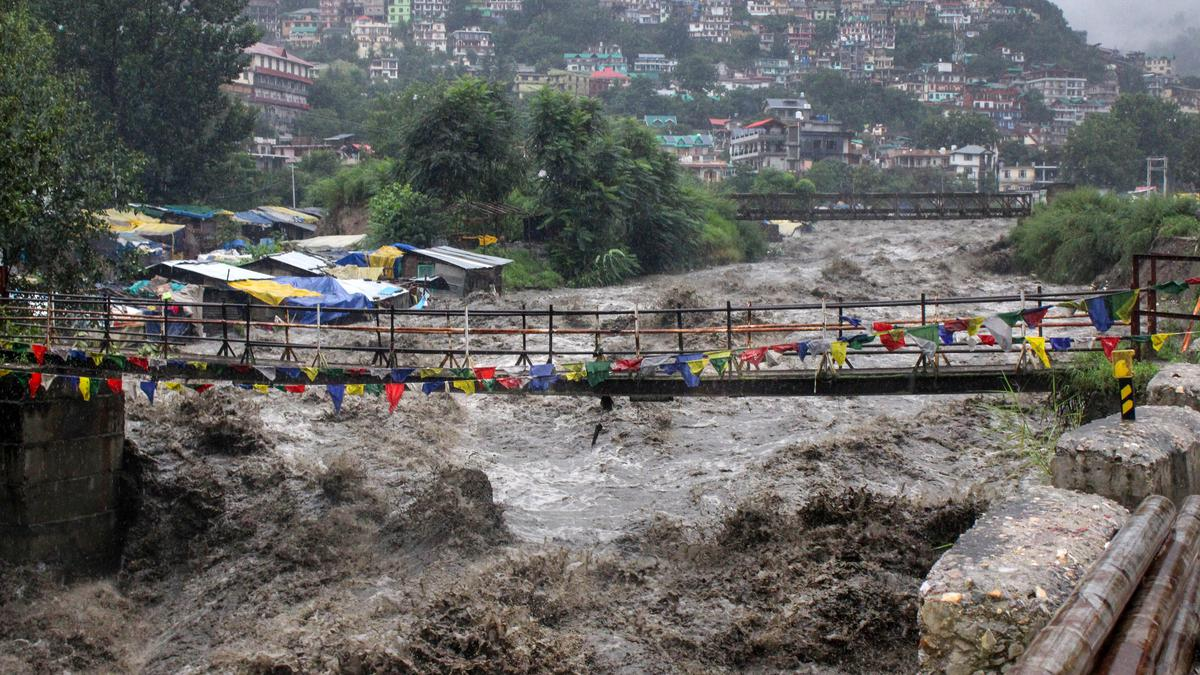
Disclaimer: Copyright infringement not intended.
Context
The unique onset and evolution of the monsoon season in India.
Details
- The onset and evolution of the monsoon season have been unique and different this year.
- Unforeseen interactions between typhoons and cyclones delayed the onset, leading to an exaggerated curvature of the monsoon trough over northwest India.
Patchy Rainfall Distribution
- Rainfall distribution remains patchy, with excess rainfall in the northern Western Ghats and Northwest India.
- Deficits are observed in a horseshoe pattern from Uttar Pradesh to Odisha, Chhattisgarh, Madhya Pradesh, and Maharashtra.
- Some areas of Himachal Pradesh experienced extreme heat alongside heavy rainfall.
Climate Change and Weather Patterns
- Climate change contributes to every weather event in a warmer and more humid world.
- Other factors, such as the El Niño, should also be considered in analyzing weather patterns.
Impact of Wildfires
- Wildfires this year have burned three times the normal area and emitted three times the amount of carbon dioxide, contributing to warming.
Excess Rainfall and the Arabian Sea
- Excess rainfall in northwest India is consistent with the warming of the Arabian Sea by about 1.5 degrees Celsius since January.
- Warm Arabian Sea and a higher number of western disturbances contributed to above-normal pre-monsoon rainfall.
Uneven Rainfall Distribution
- Despite averaging rainfall over months or even seasons, distribution remains uneven.
- Disuniform terrain and heterogeneous land-use patterns are likely factors influencing distribution.
Atlantic Ocean and Upper Atmospheric Circulation
- The entire Atlantic Ocean has been warmer than normal, potentially impacting monsoon rainfall.
- Upper atmospheric circulation patterns, influenced by mountainous terrain like the Himalaya, can drive excess rainfall.
Local Impact of Himalayan Warming
- Warming over the Himalaya is not uniform, leading to local amplification of global warming.
- Irregular weather patterns during the monsoon combine with local flow patterns, resulting in cloudbursts, heavy rains, or heatwaves.
The Indian Subcontinent as a Weather 'Popcorn Kettle'
- The Indian subcontinent is characterized as a region with unpredictable weather events.
- Not every weather event can be directly attributed to global warming, but they occur in a warmer and wetter world.
- Improved forecasts with granularity in space and time are crucial to reduce surprises and better understand weather phenomena.

About Climate Change Induced Floods
- Climate change refers to long-term alterations in temperature, precipitation patterns, and weather conditions.
- One of the significant impacts of climate change is an increase in the frequency and intensity of floods.
- Climate change-induced floods result from various factors such as heavy rainfall, sea-level rise, melting glaciers, and changes in river flow patterns.
Increased Precipitation
- Warmer temperatures lead to increased evaporation rates, which can result in more moisture in the atmosphere.
- The increased moisture content in the atmosphere leads to heavier rainfall during storms and increases the likelihood of flooding.
- Intense rainfall events can overwhelm the capacity of rivers, lakes, and drainage systems, causing floods.
Rising Sea Levels
- Climate change contributes to the melting of glaciers and ice caps, leading to an increase in sea levels.
- Higher sea levels elevate the risk of coastal flooding during storm surges and high tides.
- Low-lying areas, including coastal cities, become more vulnerable to flooding and increased erosion.
Changes in River Flow
- Climate change affects the timing and intensity of river flows.
- Changes in precipitation patterns can cause alterations in the seasonal distribution of water, leading to periods of drought followed by heavy rainfall.
- These irregular flow patterns can result in flash floods, damaging riverbanks, and inundating surrounding areas.
Impact on Infrastructure and Communities
- Climate change-induced floods pose significant threats to infrastructure, including roads, bridges, buildings, and utility systems.
- Floods can disrupt transportation networks, damage power grids, and compromise water supply and sanitation systems.
- Communities residing in flood-prone regions are at risk of displacement, loss of livelihoods, and physical harm due to floods.
Ecosystem Disruption
- Floods caused by climate change can have severe ecological consequences.
- They can lead to habitat destruction, loss of biodiversity, and contamination of water bodies with pollutants.
- Floods can also disrupt the natural balance of ecosystems by altering nutrient cycles and displacing or endangering plant and animal species.
Adaptation and Mitigation Strategies
- To address climate change-induced floods, adaptation measures include improving flood forecasting and early warning systems.
- Implementing land-use planning that considers flood risk and avoids construction in vulnerable areas.
- Constructing or improving flood protection infrastructure such as levees, flood walls, and drainage systems.
- Mitigation strategies involve reducing greenhouse gas emissions to slow down climate change and decrease the frequency and intensity of floods.
About Melting of Himalayan Glaciers
- The Himalayan mountain range is home to thousands of glaciers, including some of the largest and most significant glaciers outside the polar regions.
- These glaciers are vital sources of freshwater, feeding major rivers like the Ganges, Indus, and Brahmaputra, which provide water for millions of people downstream.
Accelerated Melting of Himalayan Glaciers
- Climate change is causing Himalayan glaciers to melt at an accelerated rate.
- Rising temperatures result in increased glacial melt, causing a reduction in the overall volume and size of glaciers.
- Several factors contribute to the melting of Himalayan glaciers, including increased air temperature, reduced snowfall, and changing precipitation patterns.
Impact on Water Resources
- The melting of Himalayan glaciers has significant implications for water resources in the region.
- Glacial meltwater contributes to the flow of major rivers during the dry season, ensuring a steady water supply for agriculture, drinking water, and hydropower generation.
- Reduced glacier volume and altered melt patterns can lead to water scarcity and disruptions in river flow, affecting downstream communities and ecosystems.
Threat to Ecosystems and Biodiversity
- Himalayan glaciers support unique ecosystems and a diverse range of plant and animal species.
- Melting glaciers disrupt the delicate balance of these ecosystems, affecting vegetation patterns, altering habitats, and threatening the survival of specialized species.
- Changes in water availability due to glacial melt can also impact downstream wetlands, riverside forests, and aquatic ecosystems.
Hazardous Glacial Lake Outburst Floods (GLOFs)
- Melting glaciers contribute to the formation of glacial lakes in the Himalayas.
- As glaciers retreat, meltwater accumulates in these lakes, increasing the risk of glacial lake outburst floods (GLOFs).
- GLOFs occur when the damming moraine holding back a glacial lake fails, releasing a sudden torrent of water downstream, resulting in devastating floods that can damage infrastructure and endanger human lives.
Socioeconomic Implications
- The melting of Himalayan glaciers poses significant socioeconomic challenges for the region.
- Communities dependent on glacial meltwater for agriculture, hydropower, and livelihoods face uncertainties due to reduced water availability and changes in timing and intensity of water supply.
- Disruptions in water resources can impact food security, energy production, and the overall economic well-being of communities.
Global Implications
- The melting of Himalayan glaciers contributes to global sea-level rise as the meltwater eventually reaches the oceans.
- The loss of glaciers also reduces the Earth's capacity to reflect sunlight, leading to further warming and climate impacts.
- The interconnected nature of the Earth's climate system means that the melting of Himalayan glaciers affects weather patterns, climate stability, and ecosystems beyond the region.
|
PRACTICE QUESTION
Q) Examine the factors contributing to the unique onset and evolution of the monsoon season in India this year. How can improved forecasting capabilities help in understanding and predicting such weather events? (250 words)
|

https://www.thehindu.com/sci-tech/science/north-india-himachal-rains-flood-climate-explained/article67064497.ece




